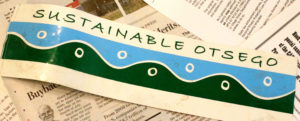COLUMN
Home Rule In
Constitution,
But Limited
By ADRIAN KUZMINSKI • Special to www.AllOTSEGO.com
 I’ve been commenting in recent columns on the first two Principles of Sustainable Otsego: Sustainable Living and Economic Independence. In this column, I want to take up the third and last principle: Home Rule.
I’ve been commenting in recent columns on the first two Principles of Sustainable Otsego: Sustainable Living and Economic Independence. In this column, I want to take up the third and last principle: Home Rule.
“Home” is where we live with family, friends, and neighbors. Its scale is small enough to sustain in-depth relationships with people and places. Home has the capacity to inspire love, not least because it embodies a complexity of human experience not otherwise available.
The largest political unit with which people identify, and which preserves this sense of community, is the county, where people from different backgrounds and neighborhoods are still able to come together on an individual, face-to-face basis for the services, commerce, education, recreation, spirituality and government which make up everyday life.
This local ethos is captured by county fairs, which exhibit the pride of local production and the resilience of local networks, as well as by local governments, chambers of commerce, health care institutions, religious groups, and philanthropic organizations, among others.
You might think that communities in New York State, like counties, already enjoy the local governance we call Home Rule, and you’d be partly right. Home rule as we know it was put into the state Constitution (Article IX) in 1963, after decades of struggle for local autonomy, led by New York City.
Today municipalities (villages and towns, cities and counties) have the right to make their own legislative decisions relating to their “property, affairs, or government,” as the Constitution puts it, independently of the state legislature.
But state law still overrides local law, and state concerns blocking local legislation have almost always been upheld in the courts.
Whether it’s a town in Otsego County or a neighborhood in New York City, increasing his production of masterpieces with strenu local communities in New York State have little control over their own backyards. Decisions about issues as diverse and disputed as energy use and infrastructure, health care costs, gun laws, abortion, pesticide use, drinking age, insurance rates, minimum wages, public education, interest rates and economic development are generally made far from home in circumstances obscure to the average individual.
There is no meaningful role for local government in state politics. Although rural towns and city wards in Otsego County send representatives to the county Board of Representatives, our county legislature, like all the others, is a political dead end. It sends no representatives anywhere.
Instead we are represented in Albany by a hodge-podge of state Assembly and Senate districts.
They either split up counties into different areas, or else lump them in together with other counties in large amorphous blobs of districts. Few people can identify the Assembly or Senate district in which they live.
Not one of our state legislators is dedicated to the particular interests of Otsego County.
There is no one who effectively speaks for the collection of communities which is our county. As a result, it is almost impossible for disenfranchised local governments to influence state and federal policies, or to resist disruptive corporate practices which state and federal governments enable.
Nonetheless, Home Rule isn’t entirely toothless. Hundreds of communities across our region of the state adopted bans or moratoria on fracking for natural gas a few years ago. These were upheld by the courts, and helped lead to the current statewide ban on fracking.
This demonstrates how much effort it takes to invoke Home Rule, and how hard it is to resist outside powers unaccountable to us. But it also shows what local self-determination can achieve when it is empowered.
To be sure, total community self-determination, with no outside check, is a recipe for chaos and conflict, for a war of all against all. No one wants that. But state and federal powers which can override local communities are recipes for tyranny. Without local checks on broader government powers, there’s nothing to prevent the special interests they serve from trumping the general interest of the people. That’s exactly what’s been happening.
New York State still hasn’t figured this out. According to a Report from the New York State Bar Association on Home Rule, “the continuing dilemma has been to strike the right balance of furthering strong local governments but leaving the state strong enough to meet the problems that transcend local boundaries.”
One way to strengthen local communities and restrict state power to a minimum is to reintegrate them into state government by giving them a real vote and voice in Albany.
New York State, for instance, might do well to abolish its sprawling, dysfunctional state Senate districts and instead have counties directly elect their own state Senators to represent them. A system of weighted voting in the state Senate, for instance, could moderate the population differences among New York’s 62 counties.
With 62 counties comprising the state Senate, state government would be a lot more responsive to community needs, and in a better position to sort out what is truly a state function and truly a community one. It’s hard to imagine how to make state government locally accountable without giving communities an actual voice in Albany.
In sum, Sustainable Otsego sees the future of Otsego County in terms of Sustainable Living, Economic Independence, and Home Rule. For more information go to the Sustainable Otsego FaceBook page, or to sustainableotsego.net
Adrian Kuzminski, a retired Hartwick College philosophy professor and Sustainable Otsego moderator, lives in Fly Creek.

